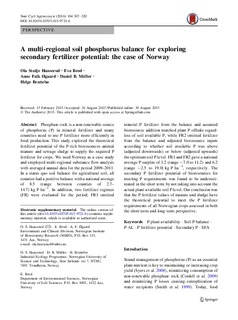| dc.contributor.author | Hanserud, Ola Stedje | |
| dc.contributor.author | Brod, Eva | |
| dc.contributor.author | Øgaard, Anne K. Falk | |
| dc.contributor.author | Müller, Daniel Beat | |
| dc.contributor.author | Brattebø, Helge | |
| dc.date.accessioned | 2019-03-05T08:56:57Z | |
| dc.date.available | 2019-03-05T08:56:57Z | |
| dc.date.created | 2015-09-03T10:30:18Z | |
| dc.date.issued | 2015 | |
| dc.identifier.citation | Nutrient Cycling in Agroecosystems. 2015, 104 (3), 307-320. | nb_NO |
| dc.identifier.issn | 1385-1314 | |
| dc.identifier.uri | http://hdl.handle.net/11250/2588678 | |
| dc.description.abstract | Phosphate rock is a non-renewable source of phosphorus (P) in mineral fertilizer and many countries need to use P fertilizer more efficiently in food production. This study explored the theoretical fertilizer potential of the P-rich bioresources animal manure and sewage sludge to supply the required P fertilizer for crops. We used Norway as a case study and employed multi-regional substance flow analysis with averaged annual data for the period 2009–2011. In a status quo soil balance for agricultural soil, all counties had a positive balance with a national average of 8.5 (range between counties of 2.7–14.7) kg P ha−1. In addition, two fertilizer regimes (FR) were evaluated for the period; FR1 omitted mineral P fertilizer from the balance and assumed bioresource addition matched plant P offtake regardless of soil available P, while FR2 omitted fertilizer from the balance and adjusted bioresource inputs according to whether soil available P was above (adjusted downwards) or below (adjusted upwards) the optimum soil P level. FR1 and FR2 gave a national average P surplus of 1.2 (range −7.0 to 11.2) and 6.2 (range −2.5 to 19.0) kg P ha−1, respectively. The secondary P fertilizer potential of bioresources for meeting P requirements was found to be underestimated in the short term by not taking into account the actual plant-available soil P level. Our conclusion was that the P fertilizer values of manure and sludge have the theoretical potential to meet the P fertilizer requirements of all Norwegian crops assessed in both the short-term and long-term perspective. | nb_NO |
| dc.language.iso | eng | nb_NO |
| dc.publisher | Springer Verlag | nb_NO |
| dc.rights | Navngivelse 4.0 Internasjonal | * |
| dc.rights.uri | http://creativecommons.org/licenses/by/4.0/deed.no | * |
| dc.title | A multi-regional soil phosphorus balance for exploring secondary fertilizer potential: the case of Norway | nb_NO |
| dc.type | Journal article | nb_NO |
| dc.type | Peer reviewed | nb_NO |
| dc.description.version | publishedVersion | nb_NO |
| dc.source.pagenumber | 307-320 | nb_NO |
| dc.source.volume | 104 | nb_NO |
| dc.source.journal | Nutrient Cycling in Agroecosystems | nb_NO |
| dc.source.issue | 3 | nb_NO |
| dc.identifier.doi | 10.1007/s10705-015-9721-6 | |
| dc.identifier.cristin | 1261697 | |
| dc.description.localcode | © The Author(s) 2015. This article is distributed under the terms of the Creative Commons Attribution 4.0 International License (http://creativecommons.org/licenses/by/4.0/), which permits unrestricted use, distribution, and reproduction in any medium, provided you give appropriate credit to the original author(s) and the source, provide a link to the Creative Commons license, and indicate if changes were made. | nb_NO |
| cristin.unitcode | 194,64,25,0 | |
| cristin.unitname | Institutt for energi- og prosessteknikk | |
| cristin.ispublished | true | |
| cristin.fulltext | original | |
| cristin.qualitycode | 1 | |

